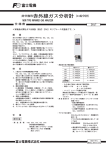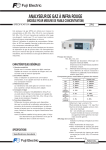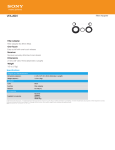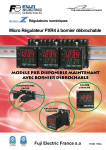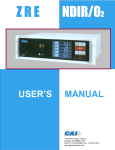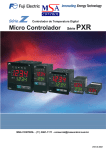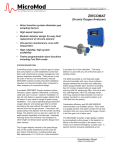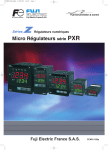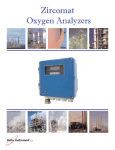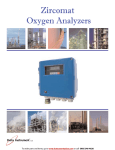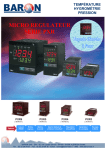Download ZIRCONIA OXYGEN DETECTOR SERVICE MANUAL
Transcript
Service Manual ZIRCONIA OXYGEN DETECTOR SERVICE MANUAL TYPE: ZFK 3, 4, 7 TN5A0281a-E CONTENTS 1. PREFACE .........................................................................................................................................2 2. MEASUREMENT PRINCIPLE..........................................................................................................2 3. ADJUSTMENT .................................................................................................................................3 3.1 Zero (Air) Adjustment ....................................................................................................................... 3 3.2 Span Adjustment .............................................................................................................................. 3 4. TROUBLE CHECK SHEET ..............................................................................................................4 5. REPAIR.............................................................................................................................................5 APPENDIX Wiring Diagram.................................................................................................................6 Output characteristic table................................................................................................7 -1- 1. PREFACE This service manual explains repair and adjustment procedure of the Zirconia oxygen detector (ZFK 3, 4, 7) as a single unit. This manual is intended for use with the instruction manual (INZ-TN4ZFK3). 2. MEASUREMENT PRINCIPLE When yttria-stabilized zirconia ceramic is heated to hightemperature, only the oxygen ion becomes a movable solid electrolyte. In a zirconia element, the both sides of which are fitted with a platinum electrode, the electrode reactions in the following expressions occur for the oxygen concentrations P1 and P2 (P1 > P2). Electrode of P1 side O2 + 4e → 20¯ ¯ (negative electrode) Electrode of P2 side 20¯ ¯→ O2 + 4e (positive electrode) Heater Insulating material Casing Filter Air P1 P2 Measured gas Output Electrode Fig.1 Zirconia element Detector structure That is, the oxygen ion moves from the P1 side, where oxygen concentration is higher, to P2 side, where it is lower. This energy for moving the ion generates the electric force (E) indicated in the following expression. E= P (O ) RT 1n 1 2 (V) 4F P2 (O 2 ) =50.74 log E P1 (O2) P2 (O2) R T F P1 (O 2 ) (mV) (at 800 °C) P2 (O 2 ) : Electric force : Comparative (Air) oxygen concentration : Oxygen concentration in the measured gas : Gas constant 8.3144 (J·moℓ-1·K-1) : Absolute temperature : Faraday constant 9.649 × 104 (c·moℓ-1) ∗ Coefficient 50.74 is the value when the zircornia element is 750°C. (The sensor unit becomes 750°C with 800°C temperature control.) Therefore, unknown oxygen concentration P2 (O2) can be calculated from the electric force (E). -2- 3. ADJUSTMENT 3.1 Zero (Air) Adjustment 1) Remove the 3 screws fixing the case cover. 2) Feed the zero gas (Dry Air) through the sample gas inlet (on the lower side of the main unit) at the specified flow rate (0.5L /min). 3) After the voltage indication between the external terminals block (4) and (5) (the terminal block on the front panel 7P) is stabilized (feed zero gas for 2 to 3 minutes), adjust the indication to 0 ± 1mV by VRZ on the printed board; ZFK 3, 4. For ZFK7, make sure that the indication is within ± 3mV. (No adjustment) 3.2 Span Adjustment 1) Feed the span gas (1 to 2% O2/N2) at the specified flow rate. 2) After the indication is stabilized, adjust it by VRS; ZFK 3, 4 Find the adjustment value using the following expression. E (Output:V) = 0.3812 × log 21/Px Px:Calibration gas concentration Example) In case of 1.1% O2/N2 E=0.3812 × log 21/1.1 = 0.488v Make an adjustment with the VRs control so that 0.488V is obtained. 1 2 SSR 2 CN3 1 C1 R5 CN1 C3 ZD2 ZD1 ZD4 ZD3 8 C2 R1 1 Fig.2 TK4B5692R2 3 4 VRZ 3 R8 R2 R7 R3 CN2 1 3 1 Zero VR VRZ 01 C4 JAPAN R4 VRS 1 6 Span VR VRS Printed board mounting diagram; ZFK 3, 4 For ZFK7, make sure that the indication is within 50 to 70mV when the gas with concentration of 1 to 2 % O2/N2 is flowed. (Refer to Appendix Table 2.) (No adjustment) -3- 4. TROUBLE CHECK SHEET Phenomena Slow response Cause Sensor element deterioration Sample gas is not supplied or output is abnormal. Sensor outlet is clogged with crystallized sulfate mist. Output is unstable ZFK 3, 4 Disconnection of connector or poor contact Disturbance noise Sensor element deterioration Output is not deflected or remains the same. Fuse is blown out or power is not supplied. ZFK 3, 4 Disconnection of connector or poor contact Sensor is defective. Solid relay is defective. Printed board is defective. Output swings over. ZFK 3, 4 Constant voltage power supply is defective. Temperature controller is defective. Measuring range is exceeded. Checking methods (normal value) Change over between zero and span gas and check if 60 seconds or longer is needed for 90% response. Visually check for clogging of the outlet of the gas introduction case. Check if the connector is disconnected or move the connector part to check for the indication change. Check if output is hunting. Flow zero/span gas continuously for 10 minutes or so, and observe the indication status. Check the fuse and the supply voltage specification. Protective measures Replace Remove the clogging. Replace with a gas introduction case (provided with gas outlet pot). Repair Eliminate noise. Replace the sensor element. Replace the fuse or check the power supply. Check if the connector is disconnected or move the connector part to check for the indication change. Change over between zero and span gas and check for the indication change. Remove one end of the sensor terminal block (3) – (4), and check for continuity. The range should be within 2 to 3 Ω. When 24V DC is applied to the outer end (7) – (8) (-), check if AC power between (1) – (2) on the sensor element is turned on or off. (Check with a tester.) Change over between zero and span gas and check if the voltage value between the sensor outer end (5) – (6) (+) indicates as shown below. Air: ± 3mV or lower 1 to 2% O2/N2: 50 to 70mV. Check if the CN2 of the constant voltage power supply indicates 12 ± 0.1V. Repair Check if the temperature indication is constant in a range of 800 ± 5 °C. Replace the temperature controller. Flow measured gas after zero/span calibration. Review the specifications. -4- Replace the sensor element. Replace the printed board or the solid relay. Replace the printed board or the solid relay or sensor element. Replace the constant voltage power supply. 5. REPAIR (1) Replacement of the sensor element 1) Change the measuring gas line to the Air atmosphere and then turn off the power switch. When the device is operating, install an oxygen meter by bypass piping. Leave the device for about 30 minutes till it cools down. 2) Remove the case cover (a). 3) Remove the 6 wires connected to the sensor terminal block (b) and the 3 M4 screws fixing the sensor (c). 4) Pull out the sensor (d) from the sensor case (e), and assemble the new sensor in reverse order of disassembly. After wiring is checked, perform energization and running to calibrate zero/span. When replacing the sensor element, also replace the packing with a new one. (2) Replacement of the sensor case 1), 2) Follow the procedure in Item (1). 3) Remove the 3 M4 screws fixing the sensor (c). 4) Remove the 2 screws fixing the sensor case from the bottom of the main unit, and remove the sensor case from the top. 5) Assemble a new sensor in reverse order of disassembly. (3) Replacement of the printed board (ZFK 3, 4) 1), 2) Follow the procedure in Item (1). 3) Remove the 8 wires connected to the terminal block of the printed board and 3 screws fixing the printed board. 4) Assemble a new printed board in reverse order of disassembly. Perform energization and running to calibrate zero/span. (4) Replacement of the temperature controller 1), 2) Follow the procedure in Item (1). 3) Remove the 2 screws from the top of the temperature controller and the socket from the backside, and pull out the controller forward. 4) Assemble a new temperature controller in reverse order of disassembly. (5) Replacement of the constant voltage power supply (ZFK 3, 4) 1), 2) Follow the procedure in Item (1). 3) Remove the 5 wires and the 2 side fixing screws connected to the upper terminal block of the constant voltage power supply (g), and remove the constant voltage power supply. 4) Assemble a new constant voltage power supply in reverse order of disassembly. & ' ! " ( $% Fig.3 -5- # $% ! " Internal diagram of the oxygen analyzer APPENDIX Wiring Diagram ZFK3,4 R T Power supply SW F. 3A 85 to 265V AC 85 to 265V AC Temperature 11 10 controller PXR4 2 1 Approx. 8mV/800˚C 5 4 7 8 mV 85 to 265V AC O2 DCV 6 7 OUT CN1 Amp. P.C.B 8 1 SSR IN 2 3 4 5 6 7 R T E 101 102 103 104 1 ZFK 2 CN3 C Power supply SW F. 3A 85 to 265V AC 7 8 2 1 4 3 2 1 SSR 104 103 100 to 115V AC 1 2 3 Heat 4 5 R 6 OUT C ZFK 200 to 220V AC Temperature alarm 102 101 O2 OUT 100 to 115V AC 200 to 220V AC Temperature alarm When the setting value (800˚C) is exceeded by ±20˚C Output ZFK7 5 4 6 1 Main power Temperature supply alarm Output Temperature 11 10 controller PXR4 4 5 R Heat + - R T 2 3 -6- 104 IN 4 5 103 2 3 102 1 0 101 Constant AC AC 12V voltage DC POWER power SUPPLY supply C APPENDIX TABLE 1 ZFK 3, 4 Zirconia oxygen Analyzer Output characteristic table (ZFK 3, 4 output) %O2 OUTPUT (mV) 0.05 1000 0.1 885.3 0.5 618.8 1.0 504.0 2.0 389.3 3.0 322.2 4.0 274.5 5.0 237.6 6.0 207.4 7.0 181.9 8.0 159.8 9.0 140.3 10.0 122.8 11.0 107.1 E (OUTPUT : V) = 0.3812 log 21/O2% %O2 12.0 13.0 14.0 15.0 16.0 17.0 18.0 19.0 20.0 21.0 22.0 23.0 24.0 25.0 OUTPUT (mV) 92.7 79.4 67.1 55.7 45.0 35.0 25.5 16.6 8.8 0.0 -7.7 -15.1 -22.1 -28.9 APPENDIX TABLE 2 ZFK 3, 4, 7 Zirconia oxygen Analyzer Detector Output characteristic (internal sensor) %O2 OUTPUT (mV) 0.01 168.57 0.02 153.3 0.03 144.36 0.04 138.02 0.05 133.1 0.1 117.83 0.2 102.56 0.3 93.62 0.4 87.28 0.5 82.36 0.6 78.35 0.7 74.95 0.8 72.01 0.9 69.41 1.0 67.09 2.0 51.82 3.0 42.88 4.0 36.54 5.0 31.62 6.0 27.61 E (OUTPUT : mV) = 50.74 log 21/O2% %O2 7.0 8.0 9.0 10.0 11.0 12.0 13.0 14.0 15.0 16.0 17.0 18.0 19.0 20.0 20.6 21.0 22.0 23.0 24.0 25.0 -7- OUTPUT (mV) 24.21 21.27 18.67 16.35 14.25 12.33 10.57 8.93 7.41 5.99 4.66 3.40 2.21 1.08 0.4238 0 -1.025 -2.005 -2.943 -3.84










